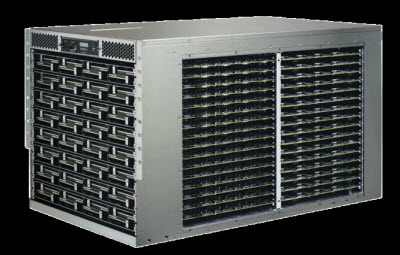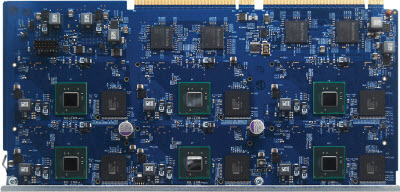 For the third time in nine months, SeaMicro is announcing a new line of servers that can pack an awful lot of computing power in a sixth of the usual space and a quarter of the electricity.
For the third time in nine months, SeaMicro is announcing a new line of servers that can pack an awful lot of computing power in a sixth of the usual space and a quarter of the electricity.
SeaMicro shook up the world of data center computing by making energy-efficient servers built around Intel’s low-power Atom chips, which are usually used in netbooks and laptops.
“This is more computing power in a given space than anyone has ever built for an Intel system,” said Andrew Feldman, chief executive of SeaMicro, in an interview. “In the past nine months, we have brought a drumbeat of innovation to the server industry.”
The advantage of Sunnyvale, Calif.-based SeaMicro’s small and power efficient computers is that enterprises can now shove a lot more computing power into a given amount of space and use a lot less electrical power, thereby cutting costs such as electricity bills dramatically.
Sales of previous systems have been doubling each quarter, Feldman said. If that pace continues, Feldman said SeaMicro could become the fastest-growing system company in Silicon Valley history. SeaMicro’s customers include France Telecom, Skype, Rogers Wireless, Mozilla, eHarmony, and China Netcom BB. Hundreds of millions of internet users traverse SeaMicro’s hardware daily.
 Intel has been improving its server microprocessors by making them more power efficient. But the microprocessor only accounts for a third of the power consumption in a server. SeaMicro’s innovation lies in how it attacks the remaining two-thirds of the power consumption problem. It does so by combining a lot of the extraneous chips into a single, more-efficient custom chip, said Feldman said.
Intel has been improving its server microprocessors by making them more power efficient. But the microprocessor only accounts for a third of the power consumption in a server. SeaMicro’s innovation lies in how it attacks the remaining two-thirds of the power consumption problem. It does so by combining a lot of the extraneous chips into a single, more-efficient custom chip, said Feldman said.
SeaMicro can put 384 Intel Atom dual-core processors (for a total of 64-bit 768 cores) in a 10-rack system, which is just 17.5 inches high. The new SM10000-64HD is a 20 percent improvement over SeaMicro’s previous server line and a 150 percent improvement on its compute density record, or the amount of computing power in a given space.
This single machine can replace rival systems with a bunch of equipment: 60 traditional servers, four rack switches, four terminal servers, and a load balancing server. It uses a quarter of the power and a sixth of the space.
SeaMicro can put an entire server on a motherboard (pictured below) that is 5 inches by 11 inches. Since the hardware is Intel-based, customers don’t have to change their software at all.
Intel no doubt likes the fact that SeaMicro can work such wonders with Intel Atom N570 chips while maintaining software compatibility.
 “SeaMicro continues to drive innovation in the microserver market,” said Jason Waxman, general manager of Intel’s Data Center Group, who noted that SeaMicro can get the equivalent of 3,000 processors running at a combined total of 5,100 gigahertz.
“SeaMicro continues to drive innovation in the microserver market,” said Jason Waxman, general manager of Intel’s Data Center Group, who noted that SeaMicro can get the equivalent of 3,000 processors running at a combined total of 5,100 gigahertz.
But Feldman notes that SeaMicro could just as easily use ARM processors in its servers, if customers wanted that. SeaMicro’s previous SM10000-64 server had 256 dual-core Atom processors for a total of 512 cores in a 10-rack unit.
Feldman acknowledges the SM10000-64HD is a pretty nerdy name for the company’s latest server. I suggest they call it the Atom Bomb.
Zeus Kerravala, an analyst at the Yankee Group, a market analyst firm, said that SeaMicro has delivered three servers in nine months, each time setting the record for energy efficiency and compute density. The list price is $237,000 for the new server, which has been shipping for 10 days. Feldman said previous units have sold millions of dollars worth.
SeaMicro was founded in 2007 and is backed with $60 million in funding by Khosla Ventures, Draper Fisher Jurvetson, Crosslink Capital, as well as a number of strategic investors. It also won grants from the U.S. Departement of Energy ($9.3 million) and the state of California ($250,000). SeaMicro has 80 employees. Most recently, SeaMicro raised $20 million.
Here’s what we said in past stories about how SeaMicro’s servers work:
SeaMicro also attacked the power consumption with a very clever trick known as virtualization.
Today, virtualization is frequently used with servers. It is a layer of software that rests between an application and the servers that it runs on. If an application needs only two servers, the virtualization software finds two available servers to run the application. If the application gets busy and needs 10 servers, the virtualization software finds 10 available servers to do the job. The application is no longer tied to specific servers; the virtualization software frees up the overall system and gets more utilization out of the available servers.
SeaMicro did the same thing, but it applied the concept of virtualization to the inside of a server. Feldman designed custom chips that could take the tasks that were handled by everything beyond the Intel microprocessor and its chip set. The custom chips virtualize all of those other components so that it finds the resource when it’s needed. It essentially tricks the microprocessor into thinking that the rest of the system is there when it needs it.
SeaMicro virtualized a lot of functions that took up a lot of space inside each server in a rack. It also did the same with functions such as storage, networking, server management and load balancing. Full told, SeaMicro eliminates 90 percent of the components from a system board. SeaMicro calls this CPU/IO virtualization. With it, SeaMicro shrinks the size of the system board from a pizza box to the size of a credit card.
By boiling down the rest of the system into a couple of chips, SeaMicro can get rid of a lot of the components in a system, thereby getting rid of space, cost, and power consumption.
VentureBeat's mission is to be a digital town square for technical decision-makers to gain knowledge about transformative enterprise technology and transact. Learn More
